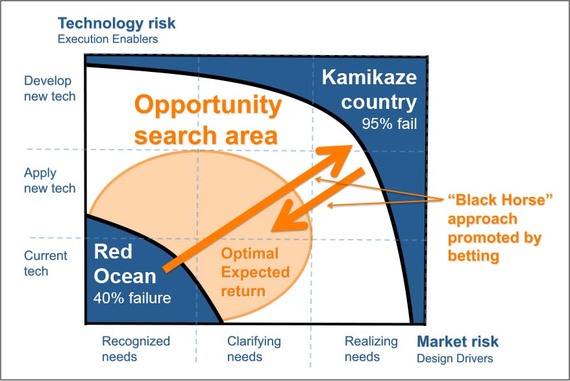Guiding design teams though the design innovation process is one of the biggest challenges in new product development (NPD). The path is strewn with ambiguity and uncertainty. Any advice that the project manager can offer rests on their previous experience, which may be highly context dependent and not directly translatable to the current design process. Gamification offers an alternative to the way in which business innovation is done today.
In the fall of 2013, our design research team at Seoul's Hanyang University had an opportunity to study how gamification changes a design team's behavior toward increased exploration of breakthrough innovations. In the spring, we first measured the teams' risk risk-attitude, without intervention to establish a baseline and then, in the fall, we experimented with how the wisdom of crowds, though gamification, could be used to promote breakthrough innovations. The fundamental idea of the wisdom of crowds is that the collective intelligence of a crowd will converge on a solution, which is better than that of any one individual.
We found that when teams bet on themselves and each other, about who can create the most promising innovative business opportunity, this action fosters a special kind of competition. This competition spurred the teams on to explore more ground-breaking innovations for a longer period of time while, in the end, also arriving at better business opportunities then those achieved without gamification.
These findings obviously promise improvements in the development of breakthrough innovative businesses and can immediately be applied to a crowdsourcing contest. However, whether gamification can be effectively used internally in design and development departments and be considered as possible to implement remains to be seen.
Decision-making and its consequences are often divorced from one another in organizations. At concept presentation meetings, financing, marketing, engineering, procurement, production are all invited to review and vote on design concepts. Self-centered and risk-averse behavior often leads managers to naturally promote concepts, which will be considered profitable and safe for their own department. Risky concepts will only be supported if other departments are taking the brunt of the risk while they may still profit from the concept.
When one's money is not where one's mouth is, decisions tend to be lopsided, effectively preventing collective support of the execution. For managers to walk the talk, a portion of the departments' resources could be allocated to betting on new breakthrough product development projects. Then, the quality of the individual departments decision-making over time will be reflected in their betting earnings and future betting capacity as well as in their ability to fund business opportunities that they find lucrative. In short, those best decision-makers and decision executioners, who take the collective into consideration, will be rewarded.
Are managers ready to shift paradigms from silo turf wars over resources to holistic allocation though gamification? Contests from DARPA and X Prize to American Idol have proved effective and efficient in getting external innovations done. However, taking this approach in-house may face stiff challenges from managers who wish to keep the status quo. Automotive designers, in particular, have applied a competitive approach to generate creative designs. Therefore, implementing gamification in internal design departments that are already competitive may be the best starting point for optimizing organizations decision-making and execution procedures.
